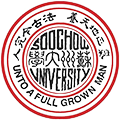Study in Soochow University About Soochow University & Study in suda
About Soochow University
Located in Suzhou, an ancient city popularly called “the Paradise on Earth”, Soochow University is a key comprehensive provincial university in Jiangsu Province and also one of China’s top 100 universities under the“Project 211” directed by the Ministry of Education. It was named after the city name Suzhou (spelt Soochow in the past) when founded in 1900, but according to the Pinyin spelling system it is now often written as Suzhou University (Suzhou Daxue or Suda in short). In 1952, the College of Liberal Arts and Science of Soochow University, Southern Jiangsu College of Culture and Education(which is composed of Jiangsu Provincial College of Education, National College of Social Education and Wuxi Junior College of Sinology)and the Department of Mathematics and Physics of Jiangnan University were merged into Southern Jiangsu Teachers’ College. Later in the same year it was renamed as Jiangsu Teachers’ College and its location was on the old campus of Soochow University. In 1982, under the approval of the State Council, Soochow University was reestablished to replace Jiangsu Teachers’ College. Then in the years of 1995, 1997 and 2000, under the approval of the Ministry of Education and Jiangsu Provincial Government, Suzhou College of Sericulture, Suzhou Institute of Silk Textile Technology and Suzhou Medical College were merged into Soochow University respectively. Better equipped and more robust, Soochow University has grown into a first-rate university in China, covering a wide range of academic disciplines including philosophy, economics, science of law, pedagogy, literature, history, natural science, engineering, agriculture, medical science and management science and enjoying a fairly high reputation both at home and abroad.
At present, Soochow University runs twenty post-doctoral research stations, six Ph.D. programs of primary disciplines, eighty-five Ph.D. programs(including self-designed majors), one professional doctoral program of primary disciplines, 209 master’s degree programs(including self-designed majors), 10 professional master’s degree programs as well as 108 undergraduate programs. The university has now about 50,000 students, including 12,744 postgraduates, 22,853 undergraduates and 9,010 adult education students. Among its 4166 faculty and staff members, four are full-time employed academicians (including one member of the Chinese Academy of Sciences who is also a member of the Third-World Academy of Sciences and three members of the Chinese Academy of Engineering), 1,633 are full professors and associate professors.
Soochow University consists of five campuses with a total area of more than 3,118 mu and a floor area of around 1.558 million square meters. The university library has a collection of about 4 million volumes and subscribes to about 2,800 domestic and foreign journals and magazines. It also has advanced equipment in the Center of Analysis and Measurement and the Center of Information Networks. The university has a publishing house which publishes academic journals such as Foreign Silk and Soochow University Journal in four discipline-oriented series.
China’s reform and opening-up policy has provided the university with excellent opportunities for international academic exchange and cooperation. Soochow University has established cooperative relationships with more than 100 universities and institutions in Japan, France, Korea, Singapore, Germany, U.S.A., Canada, Australia, Hong Kong and Taiwan. Every year the university accepts over 2,000 international students to study Chinese language and literature and other relevant majors.

